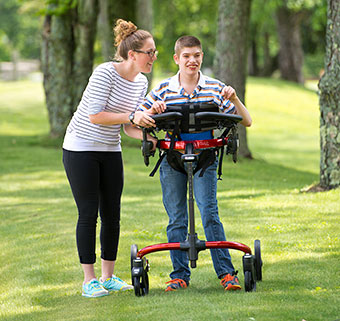 Imagine that as a therapist, you determine a client needs a gait trainer. Say it’s a child with cerebral palsy, who is young and not yet a walker, but shows the potential to become one. You know that a gait trainer – particularly one like the Rifton Pacer to which you can add and remove supportive prompts as the child’s skills develop – will be crucial in helping this child learn to walk, and improve her gait over time.
Imagine that as a therapist, you determine a client needs a gait trainer. Say it’s a child with cerebral palsy, who is young and not yet a walker, but shows the potential to become one. You know that a gait trainer – particularly one like the Rifton Pacer to which you can add and remove supportive prompts as the child’s skills develop – will be crucial in helping this child learn to walk, and improve her gait over time.
Working with a provider to get Medicaid reimbursement, you submit a letter of medical necessity , explaining the child’s disability and the features of the product, and making the case why this particular product is necessary. You even send video footage of the child’s movements using a gait trainer. You hope for the best.
Then, the request is denied by Medicaid.
Welcome to one of the most challenging experiences for a therapist. In fact, it’s challenging for everyone involved, including the child and the parents. To most of us it seems self-evident that a gait trainer will be instrumental in transforming an immobile child into a walking child. And yet the Medicaid funding reviewer doesn’t see it that way. A denied request translates to no reimbursement. No Medicaid reimbursement, for many clients with low incomes, means no gait trainer – which means no real opportunity to learn to walk.
Getting through to Medicaid Funding Reviewers
While it isn’t always the case, and guidelines for reimbursement vary from state to state, Medicaid denial is an obstacle many therapists face.
Currently we’re in touch with a therapist from a state in the southeastern US who is in the process of appealing such a ruling by a Medicaid reviewer. She’s enlisted the help of another therapist in crafting a strong appeal, and they are awaiting a response.
Ironically, the problem in this case seemed to be that the client didn’t already know how to walk, and didn’t have enough strength to support himself without certain prompts in place. The Medicaid reviewer indicated that the client would only be eligible for reimbursement if he was already able to independently bear weight, take reciprocal weight bearing steps, and steer the gait training device toward an objective.
To most of us, this ruling seems preposterous. The whole point of a gait trainer is to help bring a client to the level of ability that the reviewer identified. How is the client supposed to become a walker without the aid of a gait trainer? The purpose of a gait trainer is to bring a child from merely being able to partially bear weight, to actually taking reciprocal steps, to then bearing more weight, and to continue step-taking practice until he or she is independently walking with the support of the device. With the Rifton Pacer Gait Trainer, over time, as the client’s abilities increase, the level of support is reduced. Through this process, some children are even able to progress to the use of a regular pediatric walker.
Child Walkers and Gait Trainers: Two Different Animals
It is important to note here that a walker is in fact a very different kind of device than a gait trainer, especially compared to the Rifton Pacer Gait Trainer, which is uniquely adjustable for different needs and levels of development. Whereas a pediatric walker is used when a child is already able to bear weight and take steps, and thus merely uses the walker for balance support, a gait trainer like the Pacer is used when child needs to learn to walk, to improve walking ability, develop weight-bearing strength, and develop a healthier gait. Unlike a standard walker, the Pacer’s supportive prompts enable active participation and promote valuable motor learning, strength gains, and adaptive mobility. As the child or adult gains skills, improves function and achieves greater independence, the supportive prompts of the Rifton Pacer can be removed easily.
In the case of the therapist whose client was denied Medicaid funding for a gait trainer, it seemed as if the Medicaid reviewer was confusing gait trainers and walkers. She seemed to be saying the client should have shown considerable walking ability before being granted a gait trainer – the very device which might in time bring the child up to the walker level.
We can hope that in time and with better information that Medicaid reviewer – and others – will come to see the clear difference between the two, and recognize the crucial role of gait trainers like the Pacer in helping clients and children with disabilities improve walking ability at their own pace, with accessory prompt additions and reductions tailored to their specific needs and development.
Back to Top